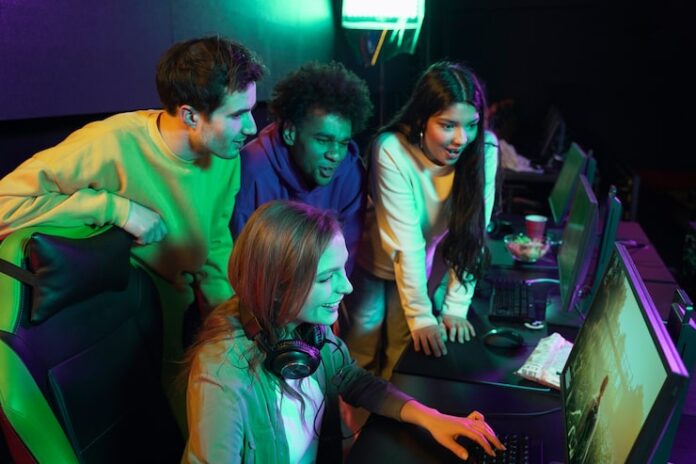Gaming Multiplayer Coordination is the key to success in competitive team-based games. In the world of esports and online multiplayer platforms, individual skill alone rarely guarantees victory. Teams that communicate effectively, plan strategically, and execute their tactics in harmony consistently outperform less organized groups. Whether you’re participating in a casual online match or a professional esports tournament, mastering multiplayer coordination transforms gameplay from chaotic to cohesive.
Understanding the dynamics of teamwork and communication is critical. Gaming Multiplayer Coordination not only improves performance but also fosters an environment where players can adapt to unexpected challenges, anticipate opponents’ moves, and maximize the potential of each team member.
Table of Contents
ToggleEstablishing Clear Roles and Responsibilities
Effective teams begin by defining each player’s role. In first-person shooters, one member might focus on reconnaissance, another on assault, while a third provides support or cover fire. In strategy games, players might manage resources, oversee defenses, or coordinate attacks. Gaming Multiplayer Coordination emphasizes clarity in responsibilities to prevent overlap and confusion during high-pressure moments.
For instance, a team playing a multiplayer battle arena game benefits from clearly defined roles: a tank absorbs damage, a damage dealer executes attacks, and a support character provides healing or buffs. This clarity allows players to concentrate on their strengths and reduces the chance of missteps during critical encounters.
Communication: The Heart of Coordination
Clear and consistent communication is essential in multiplayer environments. Teams must share real-time information about enemy positions, resource availability, and strategic opportunities. Gaming Multiplayer Coordination relies on both verbal and non-verbal cues, including voice chat, in-game markers, and quick commands, to keep everyone aligned.
Professional teams often implement structured callouts for locations and enemy actions. This level of organization allows for split-second decisions, ensuring that every member reacts in harmony rather than individually, which could compromise the team’s objectives.
Strategy Development and Adaptation
A winning team doesn’t just follow a pre-determined plan—they adapt dynamically to opponents’ tactics. Gaming Multiplayer Coordination involves preparing multiple strategies and adjusting them based on the flow of the game. Analyzing past matches, understanding meta-game trends, and studying opponents’ patterns help teams anticipate challenges and respond effectively.
For example, in a multiplayer online battle arena, a team might switch from an aggressive early-game strategy to a defensive late-game approach if the opponents dominate early objectives. Flexible strategic thinking coupled with coordinated execution gives teams a competitive edge.
Synchronizing Movements and Timing
Timing is everything in multiplayer games. Attacks, defenses, and resource usage must be synchronized to maximize impact. Gaming Multiplayer Coordination ensures that players act in concert rather than independently, reducing wasted effort and increasing the effectiveness of every move.
Consider a scenario where a group must capture a strategic point in a game. If one player advances too early, they risk being isolated and defeated. When coordinated properly, the team moves together, overwhelming opponents and securing objectives efficiently. Timing, in combination with positioning, creates synergy that outmatches uncoordinated teams.
Analyzing Performance and Feedback
Continuous improvement is a hallmark of high-performing teams. Gaming Multiplayer Coordination extends beyond the live match; reviewing gameplay, identifying errors, and incorporating feedback enhances future performance. Video recordings, statistics, and team discussions help players understand what worked, what didn’t, and how to optimize coordination in subsequent matches.
This analysis encourages accountability and growth, reinforcing individual responsibilities while highlighting areas where team synergy can improve. By fostering a culture of reflection and communication, teams build stronger connections and improve results over time.
Leveraging Individual Strengths
While coordination is crucial, recognizing and leveraging individual strengths ensures that the team functions at its highest potential. Gaming Multiplayer Coordination involves assessing each player’s skills and assigning tasks that amplify their effectiveness. A player with exceptional aim may lead offensive operations, while a tactical thinker may focus on planning and support roles.
By combining diverse strengths, teams create a balanced approach where each member contributes uniquely, resulting in a more adaptable and formidable unit.
Mental Resilience and Team Morale
High-pressure multiplayer matches can be stressful. Gaming Multiplayer Coordination encompasses not only tactical alignment but also maintaining morale and mental resilience. Teams that encourage positive communication, celebrate successes, and learn from setbacks are better equipped to handle adversity.
Resilient teams adapt quickly when strategies fail, maintaining focus on the shared objective rather than dwelling on mistakes. Emotional support and encouragement sustain performance levels, especially during intense matches where coordination is critical to success.
Practice and Routine Drills
Consistent practice builds muscle memory and instinctive teamwork. Gaming Multiplayer Coordination involves training exercises that mimic competitive scenarios, refining communication protocols, and synchronizing actions under pressure. Regular drills help players anticipate each other’s moves, reduce reaction times, and enhance overall efficiency.
For example, a team might run mock battles focusing on map control, timing, and role execution. Over time, these exercises instill habits that translate into smoother gameplay and increased success in live matches.
By integrating clear roles, effective communication, strategic flexibility, synchronized actions, performance analysis, individual strengths, mental resilience, and structured practice, Gaming Multiplayer Coordination empowers teams to consistently perform at their peak, transforming cooperative gameplay into a strategic and cohesive winning force.
Read also:
phurr restaurant
bastian menu
chokhi haveli menu
virat kohli restaurant menu
sri lanka national cricket team vs bangladesh national cricket team match scorecard
bangladesh national cricket team vs sri lanka national cricket team
bangladesh national cricket team vs sri lanka national cricket team match scorecard

